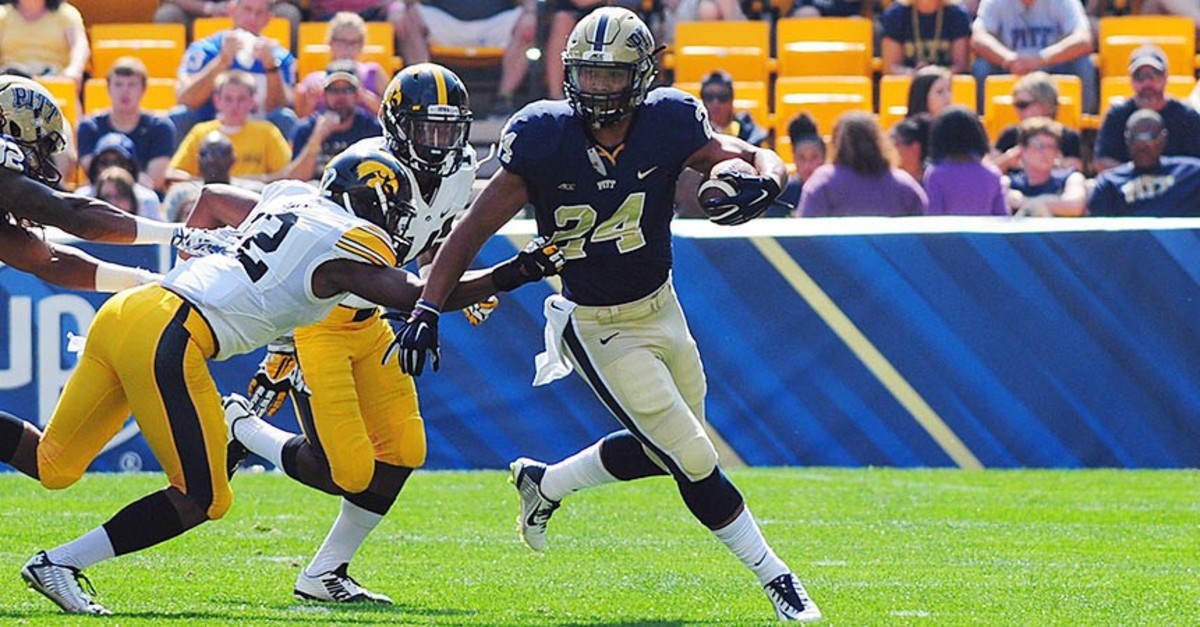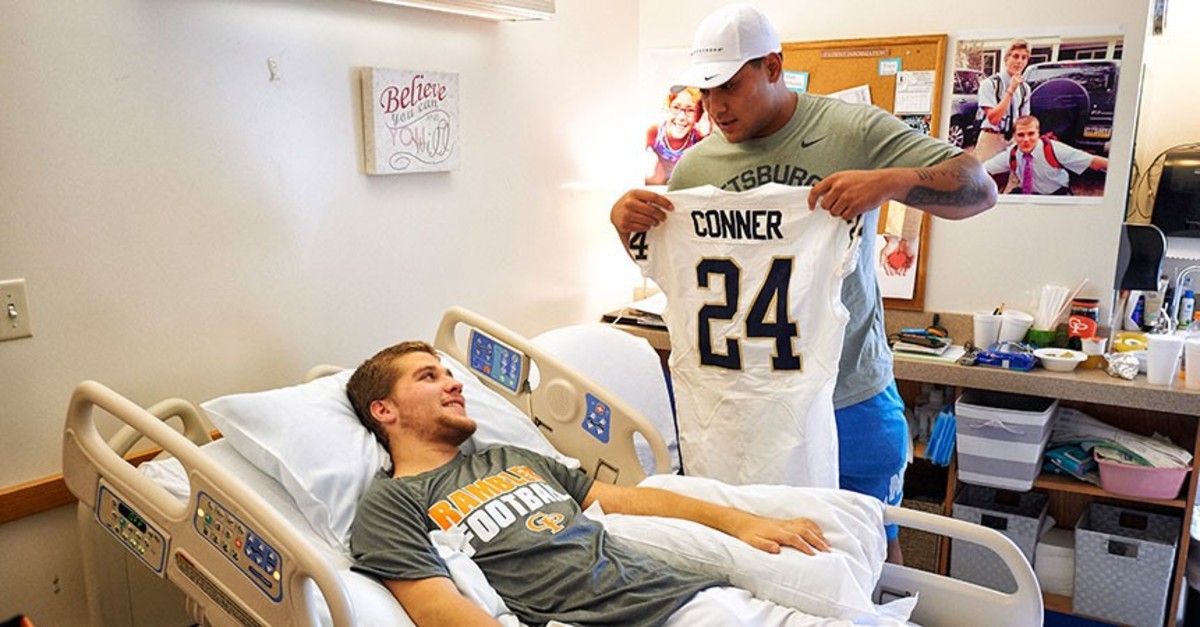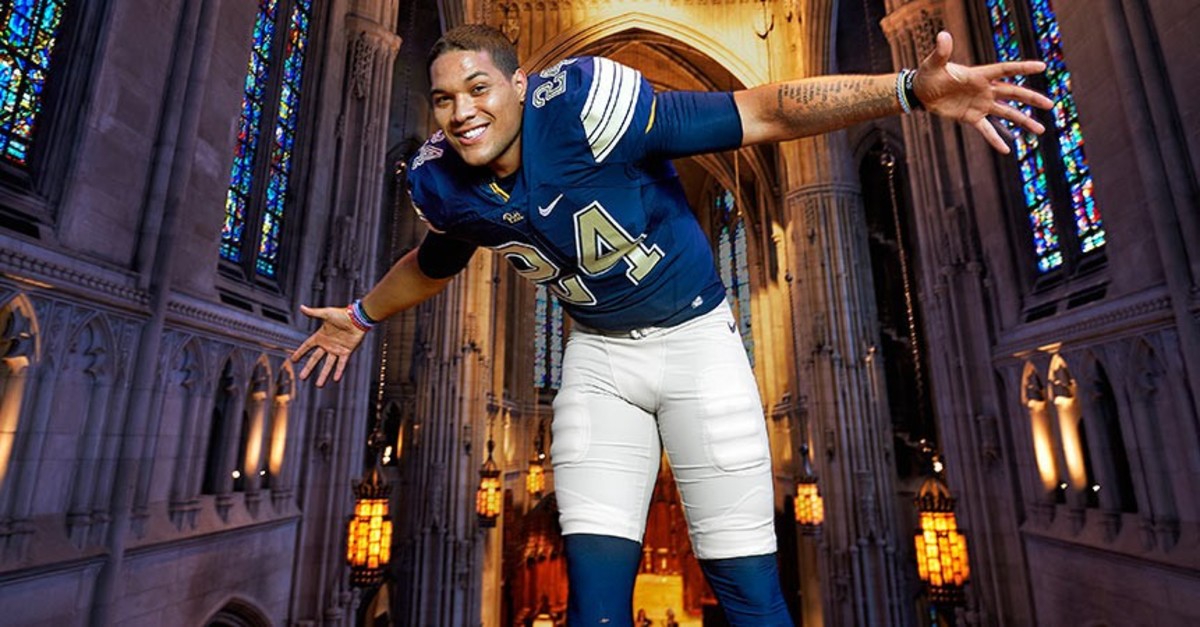'A fight can mean so many different things': Cancer, like many would-be tacklers, couldn't stop James Conner

This story appeared in the Aug. 22, 2016, issue of Sports Illustrated. Read the rest of the issue and subscribe to the magazine here.
The desktop in the football office has disappeared beneath a sprawl of letters, cards and small posters. James Conner fishes through a postal service container on his lap that is full of still more correspondence, and he is pretty sure he has yet another box of missives at his apartment. After his diagnosis of Hodgkin's lymphoma became public last December, Pittsburgh's star running back began receiving, he guesses, three to five handwritten letters a day. Some still make him smile or laugh as he revisits them months later, on the other side of the fight all these well-wishers hoped he'd win.
There's a note of encouragement from Falcons coach Dan Quinn and a letter from Mark Herzlich, the Giants' linebacker who survived Ewing's sarcoma, a rare form of bone cancer. There's a card from then Kent State women's basketball coach Danielle O'Banion, who beat non-Hodgkin's lymphoma after a diagnosis in 2014. A Little League baseball team from Hopewell, Pa., sent him a signed team picture. On a small piece of wide-ruled yellow paper, another new pen pal wrote, "I am soo sad for you that you r sek." The salutation: "From Luke to Jams."
Someone from California even sent a Star Wars coloring book, presumably to help him kill time during chemotherapy sessions. "I've actually never seen Star Wars before," Conner says, shrugging. "It's the thought that counts."
He refuses to name a favorite, but one has earned special attention: a plaque from a team of Navy SEALs. The inscription opens by imploring Conner to never quit. He flicks at his 2014 ACC player of the year trophy on the desk. "This," he says of the plaque, "is better than any of that."
A few hours later, in the hospital room of Ian Malesiewski, Conner turns over his left arm, where he has had the rest of the inscription from the SEALs tattooed. He reads it to Ian, who was wrestling in the Greco-Roman nationals on June 3 when he fell to the mat forehead-first and fractured his C4 vertebra. "Persevere and thrive on adversity," Conner says. "Strive to always be physically harder and mentally stronger than your opposition. If knocked down, get back up. Every time. Draw on every remaining ounce of strength to accomplish your life's mission. You are never out of the fight."
He looks at Ian, who was paralyzed from the chest down. "A fight," Conner says, "can mean so many different things."
*****

Matt Kincaid/Getty Images
On Sept. 5, 2015, James Conner began his junior season as one of the best players in the country. His 1,765 rushing yards and 26 touchdowns as a sophomore earned him the ACC's highest honor. He had at least an outside shot at joining Tony Dorsett as the only Pitt players to receive the Heisman Trophy. (Dorsett won in 1976.)
It was a startling rise for a kid who was recruited out of McDowell High in Erie, Pa., as a defensive end and took snaps as both a pass rusher and a running back as a freshman. But after he set the school record for rushing yards in a bowl game with 229 on 26 carries in a 30–27 win over Bowling Green in the 2013 Little Caesars Pizza Bowl, Conner's days on D were done.
JOHNSON: ACC preview: Projected standings, top storylines, more
Privately the 6' 2", 235-pound Conner hoped to put up huge numbers last year, maybe even 2,000 yards, and leave early for the NFL. Then in the opener, on his second carry of the second quarter, Conner felt a pain in his right knee. He left the game with a slight limp and did not return. Tests the next day revealed a torn right medial collateral ligament. The news ended his season. It also might have saved his life.
Conner had felt odd during his eight carries against Youngstown State, wondering why he was so winded. In the ensuing weeks, after MCL surgery, he developed a bad cough and severe night sweats. Most confounding, though, was how his face swelled during rehab. Team doctors sent Conner to an ear, nose and throat specialist, suspecting a sinus infection. The specialist told Conner there was nothing wrong with his sinuses. She did, however, want an X-ray of his chest.
Later that day the doctor called. We see something, she said.
A follow-up PET scan revealed a large mass in Conner's upper torso. A lymph-node biopsy still had to confirm it, but the doctor told Conner he most likely had cancer. It was Thanksgiving morning.
That explained the swelling. The enormous tumor adjacent to his heart impinged on his superior vena cava, the main vein that drains blood from the upper body. So when Conner exerted himself in knee-rehab workouts, the vein nearly closed, causing the blood to back up and his face to swell. And as much as the workouts stressed him, playing through the cancer, absorbing hit after stinging hit, would have been worse. "Certainly, if you know someone has a mass in their chest like that," says Stanley Marks, the chairman and director of Clinical Services for UPMC Cancer Center and the oncologist who treated Conner, "you wouldn't want them to be having contact."
Conner was told that chemotherapy had an 85% success rate. He also was told to stay off Google. "I went on Google anyways," Conner says. He attended the Panthers' regular-season finale against Miami on Nov. 27, then returned to Erie. To take his mind off the disease, he saw the movie Creed. It was no comedy, but Conner had to laugh; in the film, Sylvester Stallone's Rocky battles non-Hodgkin's lymphoma. "I was like, Aw, man, I can't escape from this thing," Conner says. "I couldn't even enjoy the movie, because I'm like, Me and Rocky both have cancer."
On Dec. 4, with stitches still in his neck from the biopsy, Conner told his teammates about the diagnosis—"You could hear a pin drop," quarterback Nate Peterman says—and later revealed it at a press conference. Fear is a choice, Conner said, and he chose not to fear cancer. Another choice carried less fanfare. "I decided to make the most out of the situation," Conner says. "Make the good bigger than the bad."
The disease, as Conner saw it, provided him a way to help. The fourth floor of Pittsburgh's Hillman Cancer Center features rooms isolated from the central chemo treatment area; Marks offered Conner a private room so no one would see if he suffered side effects. Conner refused. "I didn't want to be isolated from anybody," he says. "I'm no different." He sat in what was essentially a cubicle with his privacy window open, chatting with whomever occupied the adjacent space. He walked around and talked with patients, an IV pole in tow. And he never hid. Conner vomited at every session; he says the saline flush of his chemotherapy port created a "liquid metal" taste that turned his stomach. "For the patients he got to know, he really was an inspiration and helped get them through some of their darkest times," Marks says. "That really impressed me about the kid. That's not the way I would've expected him to behave."
The altruism was not entirely revelatory; Conner received an award for volunteer work from the National Kidney Foundation in March 2015, and he was named to the AFCA Good Works Team that September for his efforts with the Children's Hospital of Pittsburgh, the Mel Blount Youth Home, the humanitarian organization World Vision and the Kidney Foundation. That impulse to give back was nurtured, in Conner's estimation, by his family. His four older brothers instilled humility in very creative ways—they once stuffed James in a clothes dryer and turned it on—but their guidance and steadfast support became ideals to pay forward as he grew older. And his mother, Kelly Patterson, is a social worker; her daily routine of helping people through their struggles opened her son's eyes. "He gets the reality that life can be," says family friend and confidant Mike Gallagher.
After the diagnosis he told Pitt coach Pat Narduzzi, "We're going to beat it, and we're going to have a story to tell."
He even told that story to Narduzzi's 72-year-old mother-in-law, Sandra Silva, who is also battling cancer. That was more than a month after the day in May when doctors told Connor he was in complete remission. "It doesn't matter what age—people are looking at him," Narduzzi says. "How did he do it? What did he do to get this thing done? He's a hero to a lot of people."
*****

Fred Vuich
James Conner walks into The Children's Institute at 3:40 p.m on a toasty July day wearing a gray Pittsburgh Football T-shirt and holding a white game jersey. Ian Malesiewski arrived here on July 5 and will remain until at least Oct. 1. And Ian, a family friend of Gallagher's, is why Conner is here, toting part of the uniform he wore against Miami his sophomore year, when he broke Pittsburgh's single-season touchdown record, surpassing Dorsett's total of 22 before finishing the year with 26.
Ian lies in bed, under a sign that reads "Believe you can and you will." His arms rest on pillows. Medium-length hair and a beard distinguish him from the clean-shaven character with a buzz cut in two pictures on his hospital room door. Oreos and Gatorades line a shelf to his left, next to a stack of DVDs that includes Joe Dirt and Fletch. It's all evidence of an extended stay, and the long wait to get back to something approaching normal.
"How's it going?" Conner asks, taking a seat bedside.
"Been better," Ian says, "but been worse."
Their rapport comes easily, despite the uncomfortable circumstances and their ties to rival Erie high schools: Ian attends Cathedral Prep. The connection could be an athlete thing: Ian was a linebacker and fullback for Prep's Class AAA runner-up in 2015 and had early recruiting interest from Purdue (for football) and Northwestern (for wrestling). It could be a determination thing: Conner famously wore a surgical mask and ran sprints during Pitt's predawn February workouts, sometimes just 24 hours removed from chemo; Ian says he was straining so much during one therapy session that he passed out.
ELLIS: James Conner and more comeback players to watch in 2016
The two of them compare neck scars; Conner thinks his looks tough ("I don't put cocoa butter or nothing on it"), and Ian says he tells people he got his from a wolf attack. Conner watches as Halli Reid, Malesiewski's mother, scrolls through cellphone pictures of Ian's progress, and he listens to Ian talk about movement in his biceps and triceps. How the spinal cord swelling is already abating, and he's regained feeling above his forearms. How it's a matter of strengthening a connection between his brain and limbs that is, apparently, still there, although how much if any control he will get back is uncertain.
"I'm most impressed by the beard, though," Conner says, his laugh filling the room. He signs the game jersey, inscribing "Be a dawg!"—a slogan adopted by Ian's supporters—and the number 24. He tells this family of Penn State fans that he'll make sure they have tickets when the Panthers host the Nittany Lions in Week 2.
"You're going to be the next big thing," Connor tells Ian. "Your story, once you're back at it, you don't know how many lives you're going to touch. This is yours."
In the coming weeks, Conner will make good on his promise to return. He will text Halli— How's my guy doing?—and visit weekly. He will stay for dinner. He will coach Ian through a therapy session in which Ian lies on his stomach and strives to hold his neck up for a personal-best five minutes. With Conner barking You got this! Ian will do it for six.
In a quiet corner during that first encounter, Halli takes stock of her son's visitor. "He's taken something awful," she says, "and made it beautiful."
*****

Fred Vuich
On an overcast, humid morning along the Monongahela River, with a train rumbling by, the Panthers' offense breaks a huddle. At the snap James Conner takes a few steps, then bursts through a seam. He does not look like a cancer survivor. He looks like a giant car battery with legs.
"I throw him a pass, and I'm trying to throw it kind of back shoulder so he opens up," Peterman says, "and he just catches it one-handed and runs over everybody and is all fired up and wanting to talk trash to the defensive guys. That's James."
Says roommate and fellow running back Rachid Ibrahim, "He does pretty much what he used to do. I'll be like, Damn, this dude had cancer a couple of months ago. I'll forget."
Conner, still a junior in terms of eligibility, is not precisely all the way back. Over a lunchtime Caesar salad at The Cheesecake Factory, he says he's playing his way into shape, hoping to cut his weight from 250 pounds back to 235. Still, Pittsburgh strength-and-conditioning coach Dave Andrews says Conner's lean mass is at pre-injury-and-cancer levels. His broad jump and vertical leap are there too. Andrews won't divulge Conner's 40-yard-dash time, but deems it "more than acceptable. Phenomenal." And questions from NFL teams should grow increasingly moot with every checkup. "Any physician that would call me, I would say, He's fine, he's had no damage, his lungs and heart are perfect," Marks says.
Narduzzi's concern? Using Conner too much this fall. "He's a horse," the coach says, "but we don't want to ride him into the ground, either."
Selling that approach to Conner is another issue. His aim for 2016? "Accomplishing everything I did in the past, and more," he says. Football is no longer a life-or-death thing. Conner has survived an actual life-or-death thing. But football is vitally important, because it will allow him to return to normal. It is the last round of this fight.
He still wants the carries, the yards, the Heisman. "I don't want sympathy," he says. "I want to get the ACC player of the year again, but I don't want to get it because I beat cancer. I want to earn it."
The chance to do so is less than two months away as Conner paces through the morning workout. When the offense goes hurry-up, he takes every snap. In the backfield, he dips a shoulder into the chest of an oncoming pass rusher and smiles. When the drive is over, Conner walks toward teammates on the sideline, arms up, calling for the ball.
